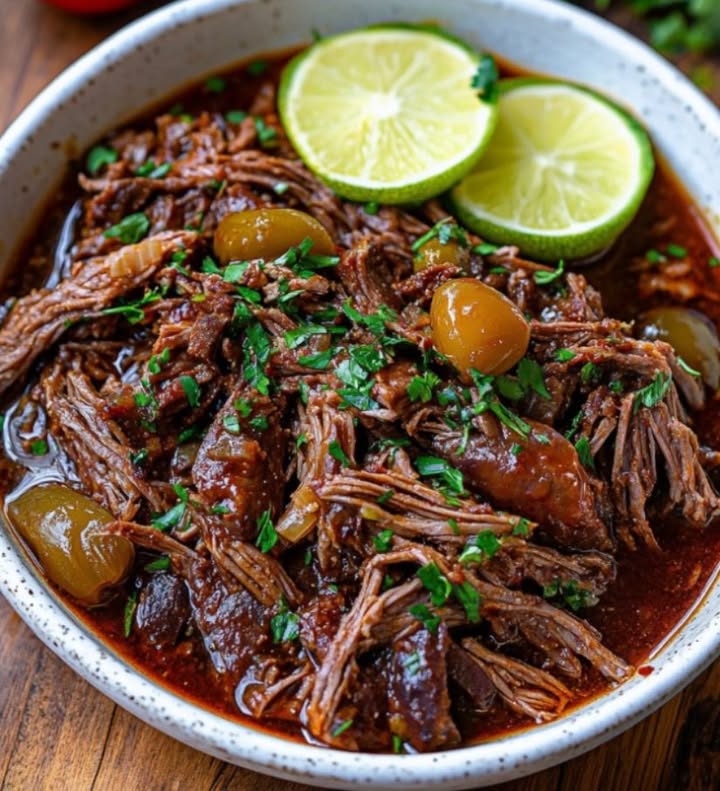Let’s Take a Culinary Trip to Cuba Without Leaving Your Kitchen
There’s something magical about Cuban cuisine. It’s bold, vibrant, and full of life—just like the island itself. One dish that always takes me back to my first visit to Havana is Cuban Shredded Beef, or Ropa Vieja. Picture this: tender, slow-cooked beef swimming in a rich sauce bursting with tomatoes, peppers, and spices. I remember sitting at a tiny café, savoring every bite alongside fluffy white rice and sweet fried plantains. That meal was unforgettable, and now I want to share it with you.
A Taste of History: The Story Behind Cuban Shredded Beef
Ropa Vieja translates to “old clothes” in Spanish, which sounds odd until you see the shredded meat resembling tattered fabric. Legend has it that this dish originated from a poor man who had nothing but old clothes to offer his family. Miraculously, they transformed into a hearty stew—a story that shows how food can bring hope even in tough times. Today, this Cuban classic is served at family gatherings, festivals, and celebrations across the Caribbean and beyond.
I decided to recreate this dish after returning home from Cuba. After some trial and error (yes, there were burnt onions involved), I nailed the perfect balance of flavors. Trust me, once you try this recipe, you’ll feel like you’ve stepped into a Cuban abuela’s kitchen.
Why You’ll Fall in Love With This Recipe
This Cuban Shredded Beef is comfort food at its finest. The slow cooking makes the beef melt-in-your-mouth tender while the blend of spices creates layers of flavor. Plus, everything simmers together in one pot, making cleanup a breeze. Whether you’re new to Cuban cuisine or already a fan, this dish will win over your taste buds—and maybe even impress your friends at dinner parties.
Perfect Occasions to Whip Up Cuban Shredded Beef
This dish shines on so many occasions. Serve it for Sunday family dinners, holiday feasts, or casual get-togethers with friends. It’s also a great option for meal prep since leftovers taste even better the next day. Pair it with rice, beans, and plantains for an authentic Cuban spread that everyone will rave about.
Ingredients You’ll Need
- 1.4 kg (3 lbs) beef brisket, chuck roast, or flank steak
- 1 tbsp olive oil
- 1 onion, thinly sliced
- 1 green bell pepper, sliced
- 1 red bell pepper, sliced
- 1 yellow bell pepper, sliced
- 4 garlic cloves, minced
- 2 tbsp tomato paste
- 2 tsp ground cumin
- 3 tsp sweet paprika
- 1/8 tsp allspice
- 1/8 tsp ground cloves
- 500 ml (2 cups) beef broth
- 410 g (1 can) crushed tomatoes
- 2 tsp dried oregano
- 2 bay leaves
- 1 cup green olives (optional)
- 2 tbsp capers
- 1 tbsp apple cider vinegar or lime juice
- Salt and pepper to taste
- 2 tbsp fresh cilantro, chopped
Substitutions and Swaps
If you can’t find certain ingredients, don’t worry! Here are some easy swaps:
- Use ground coriander instead of cumin for a slightly different flavor.
- Swap out bell peppers for whatever color you have on hand—they’ll still add sweetness and crunch.
- No beef broth? Chicken broth works just fine.
- Omit olives if you’re not a fan; their brininess adds depth but isn’t essential.
Step-by-Step Preparation
Step 1: Sear the Beef
Heat the olive oil in a large pot over medium-high heat. Pat the beef dry with paper towels (this helps it brown nicely). Once the oil shimmers, place the beef in the pot and let it sear undisturbed for 3–4 minutes per side. Look for a gorgeous golden crust forming—that’s where the flavor begins! Remove the beef and set it aside on a plate.
Pro tip: Don’t overcrowd the pot when searing. If needed, work in batches to ensure each piece gets beautifully caramelized.
Step 2: Soften the Veggies
In the same pot, toss in the onions and bell peppers. Stir occasionally as they soften and release their fragrant aromas. This step should take about 7–10 minutes. Imagine the colors melding together, creating a rainbow of reds, greens, and yellows. Add the garlic and cook for another minute—it smells amazing, doesn’t it?
Step 3: Build the Flavor Base
Stir in the tomato paste, cumin, paprika, allspice, and cloves. Cook for 1 minute, letting the spices toast slightly and intensify in flavor. Your kitchen will smell like a spice market by now!
Chef’s tip: Toasting spices enhances their aroma and gives your dish extra depth. Just keep an eye on them so they don’t burn.
Step 4: Simmer and Tenderize
Pour in the beef broth, crushed tomatoes, oregano, and bay leaves. Nestle the beef back into the pot, cover, and reduce the heat to low. Let it simmer gently for 2 hours. During this time, the beef becomes fork-tender, absorbing all those incredible flavors.
Pro tip: For hands-off cooking, transfer everything to a slow cooker and let it bubble away on low for 6–10 hours.
Step 5: Shred and Finish
Once the beef is tender, remove it from the pot and shred it using two forks. Return the shredded meat to the pot along with the olives and capers. Cook for 5 more minutes, then stir in the vinegar and season with salt and pepper. Sprinkle fresh cilantro on top before serving.
Timing Breakdown
- Prep Time: 20 minutes
- Cooking Time: 2 hours 30 minutes
- Total Time: 2 hours 50 minutes
Chef’s Secret
Add a splash of red wine during the simmering stage for an extra layer of richness. It’s my secret weapon for taking this dish to the next level.
An Interesting Fact About Ropa Vieja
Did you know that Ropa Vieja is considered the national dish of Cuba? Its popularity stems from its simplicity and heartiness, making it a staple in Cuban households for generations.
Necessary Equipment
- Large heavy-bottomed pot or Dutch oven
- Wooden spoons or spatulas
- Tongs for handling the beef
- Forks for shredding
Storage Tips
Leftovers store beautifully in the fridge for up to 4 days. Transfer the cooled beef to an airtight container and reheat gently on the stovetop or microwave. The flavors deepen over time, making leftovers almost better than the original meal.
For longer storage, freeze portions in freezer-safe bags or containers for up to 3 months. Thaw overnight in the fridge before reheating.
To refresh the dish after freezing, add a splash of broth or water while reheating to restore moisture.
Tips and Advice
- Brown the beef thoroughly—it builds a strong flavor foundation.
- Taste as you go. Adjust seasoning gradually to avoid overpowering the dish.
- If the sauce thickens too much, thin it out with a bit of broth or water.
Presentation Ideas
- Serve the beef piled high over steaming white rice with a sprinkle of cilantro.
- Garnish with extra olives and capers for visual appeal.
- Pair with golden fried plantains for a pop of sweetness.
Healthier Alternatives
Here are six ways to make this dish lighter:
- Leaner Meat: Use leaner cuts of beef like sirloin or round roast.
- Less Oil: Reduce the amount of oil used for searing.
- Low-Sodium Broth: Opt for reduced-sodium broth to cut down on salt.
- Veggie Boost:
Add diced carrots or zucchini for extra nutrition.
- Fresh Herbs: Skip dried herbs and use fresh ones for brighter flavors.
- Plant-Based Swap: Try substituting beef with jackfruit for a vegetarian version.
Common Mistakes to Avoid
Mistake 1: Skipping the Searing Step
Searing locks in juices and creates a rich base flavor. Skipping it results in bland beef. Always take the time to sear properly—it’s worth it!
Mistake 2: Overcooking the Vegetables
Cooking the veggies too long turns them mushy. Aim for soft yet slightly firm textures to retain their vibrancy.
Mistake 3: Rushing the Simmering Process
Patience is key here. Slow cooking ensures tender beef and well-developed flavors. Resist the urge to crank up the heat.
Mistake 4: Neglecting Seasoning
Season throughout the process—not just at the end. Small adjustments along the way yield balanced results.
Frequently Asked Questions
Can I use a slow cooker for this recipe?
Absolutely! After browning the beef and sautéing the veggies, transfer everything to a slow cooker and cook on low for 6–10 hours. Easy peasy.
What type of beef is best for shredding?
Chuck roast, brisket, or flank steak work wonderfully because they become incredibly tender when cooked slowly.
Can I make this dish spicy?
Yes! Add diced jalapeños or a pinch of cayenne pepper for heat. Adjust according to your preference.
Is it okay to omit olives?
Definitely. While olives add tanginess, the dish is still delicious without them.
How do I prevent the sauce from becoming too watery?
Simmer uncovered toward the end of cooking to reduce excess liquid. Alternatively, mix a teaspoon of cornstarch with water and stir it in to thicken.
Can I double the recipe?
Of course! Just make sure your pot is large enough to accommodate the increased volume.
What sides pair well with Cuban Shredded Beef?
Rice, black beans, fried plantains, and avocado salad are classic accompaniments.
How do I know when the beef is ready to shred?
The meat should easily pull apart with a fork. If it resists, give it more time to cook.
Can I prepare this dish ahead of time?
Yes! In fact, preparing it a day in advance allows the flavors to meld further. Reheat gently before serving.
What can I serve vegetarians instead of beef?
Try using jackfruit or portobello mushrooms for a satisfying plant-based alternative.
Final Thoughts
Cooking Cuban Shredded Beef is like bringing a piece of Cuba into your home. With its rich flavors, vibrant colors, and comforting textures, this dish is sure to become a favorite. So grab your apron, gather your ingredients, and let’s create something truly special together. Who knows? Maybe you’ll start a new tradition with this timeless recipe.

Cuban Shredded Beef
Ingredients
Equipment
Method
- Heat the olive oil in a large pot over medium-high heat and sear the beef for 3–4 minutes on each side, then remove and set aside.
- In the same pot, add the onions and bell peppers, cooking for 7–10 minutes until softened, then add garlic and cook for another minute.
- Stir in the tomato paste, cumin, paprika, allspice, and cloves, cooking for 1 minute to toast the spices.
- Pour in the beef broth, crushed tomatoes, oregano, and bay leaves; return the beef to the pot, cover, and simmer on low for 2 hours.
- Remove the beef, shred it with two forks, and return it to the pot with olives and capers; cook for an additional 5 minutes.
- Stir in vinegar and season with salt and pepper; sprinkle fresh cilantro on top before serving.
